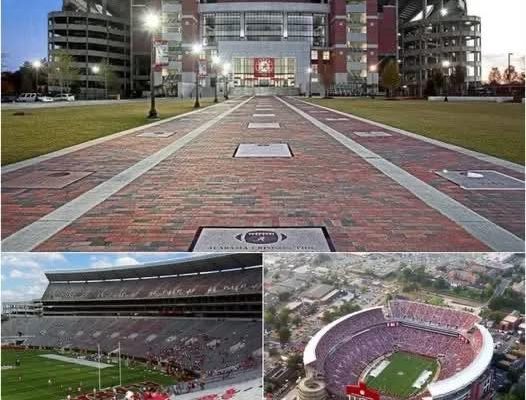BREAKING NEWS: ALABAMA CRIMSON TIDE TO BUILD COLLEGE FOOTBALL’S NEW CATHEDRAL! BRYANT-DENNY STADIUM’S MEGA-EXPANSION APPROVED \$175 MILLION…
In a move that can only be described as a thunderous statement of ambition, legacy, and relentless dominance, the University of Alabama has officially approved a historic \$175 million expansion to Bryant-Denny Stadium, setting the stage for what insiders are already calling college football’s “new cathedral.” The heart of Tuscaloosa will soon beat louder than ever before, echoing with the cheers of nearly 120,000 fans in a marvel of modern engineering fused with old-school Southern football soul. The move signals a resounding affirmation that Alabama isn’t just resting on its laurels of national championships and NFL pipeline prestige — it’s forging ahead, building a monument to the past, present, and future of the sport.
The announcement, made jointly by university president Dr. Stuart Bell and athletic director Greg Byrne, was met with thunderous applause during a press conference that felt more like a coronation. As renderings were unveiled and architects detailed their ambitious timelines, fans across the country — and especially throughout the Southeast — realized that this wasn’t just about adding more seats or updating the scoreboard. This was Alabama redefining the standard, once again. This was the school that had already set the bar, choosing to raise it again — not out of necessity, but out of an insatiable hunger to remain at the pinnacle of college football relevance.
The project is expected to take approximately two years to complete and will be rolled out in stages, ensuring that the Crimson Tide never has to leave its hallowed home turf during the transition. The centerpiece of the plan? A complete overhaul and vertical expansion of the north and south ends of the stadium, which will bring the seating capacity to just shy of 120,000 — making Bryant-Denny not only the largest stadium in the Southeastern Conference but positioning it to rival Michigan Stadium’s “Big House” for the largest crowd in college football history. Alabama isn’t just aiming for supremacy on the field; it’s gunning for supremacy in experience, spectacle, and sheer scale.
But capacity alone doesn’t tell the full story. In a nod to modern expectations of comfort and technology, the new Bryant-Denny will include over 50 new luxury suites, a three-story club tower overlooking midfield, and a sprawling glass atrium that will house a museum-like hall of champions. This interactive space will showcase Alabama’s storied history, including its 18 (and counting) national titles, Heisman winners, NFL legends, and of course, a shrine to the Saban dynasty. The goal, according to Byrne, is to create “the Louvre of college football,” a living, breathing gallery where every visitor — be they a first-time freshman or a lifelong fan — is immersed in the grand narrative of Alabama football.
Also included in the plans are massive upgrades to the sound system, a 360-degree concourse allowing fans to circle the stadium without missing a second of the action, and the construction of an underground players’ tunnel featuring programmable LED walls to hype the team pregame. The student section will be expanded and reconfigured for maximum impact, now directly connected to the band, forming what will likely become one of the loudest and most intimidating walls of sound in all of sports. “We want opponents to feel like they’re walking into the Coliseum,” said lead project architect Dan Meacham. “Not just a stadium, but something almost mythic.”
And of course, no Alabama project would be complete without a focus on recruiting. Adjacent to the stadium’s new west wing will be a state-of-the-art recruiting lounge complete with interactive VR tours, player highlight reels projected in 4K resolution, and live feeds from practice fields and player performance data centers. When five-star prospects visit campus, they won’t just see tradition — they’ll step directly into the future. “We’re not just building a bigger stadium,” Nick Saban said in a pre-recorded video message during the announcement. “We’re building the ultimate competitive edge.”
For many, the timing of this expansion is no coincidence. With Saban entering the twilight of his career, the university seems determined to ensure that the program he built doesn’t just maintain dominance — it transcends it. This stadium, according to many boosters and alumni, is both a thank you and a torch-passing gesture. “Nick gave us the greatest era in Alabama football history,” said Crimson Tide Foundation board member Trent Wallace. “Now it’s our turn to give something back. And what better way than by creating a stadium so iconic it ensures we stay at the top long after he’s gone?”
Financially, the project is expected to be funded through a blend of private donations, athletic revenue, and corporate sponsorships, with several Fortune 500 companies reportedly already lining up for naming rights to different parts of the new structure. Early estimates predict that within five years of its completion, the stadium will generate over \$60 million annually through premium seating, increased merchandise sales, events, and expanded media rights. But make no mistake: this move is less about revenue and more about power. Alabama already prints money in the college football economy. This is about fortifying the brand, electrifying fan experience, and outpacing the ever-evolving arms race of the sport.
Reactions from the college football world came quickly. Georgia fans scoffed at the notion that Alabama needed to “buy” its intimidation, while Ohio State supporters pointed to their own facilities as superior in infrastructure. But even detractors conceded one thing: Alabama doesn’t do anything halfway. If they say they’re building the next cathedral, then every nail, beam, and brick will be laid with generational excellence in mind. LSU athletic director Scott Woodward put it plainly: “If they pull this off the way it’s being described, everyone else better start scrambling.”
Local businesses in Tuscaloosa are already preparing for a boom in economic activity. With increased capacity and year-round accessibility to the museum and club spaces, the stadium will become more than just a Saturday venue. It will serve as a cultural hub, a destination site for fans and tourists, and a potential hosting ground for concerts, mega-conferences, and even neutral-site NFL games. City council member Jasmine Greer, whose district encompasses much of the campus area, described the project as “transformative for the Tuscaloosa economy and identity.” Greer added, “This isn’t just an upgrade — this is a legacy project that cements our city’s place on the national map.”
Construction is slated to begin following the conclusion of the upcoming season, with phase one focusing on structural expansions and groundwork for future towers. During the building process, Bryant-Denny will operate at slightly reduced capacity, but the university has already worked out temporary seating adjustments to maintain a game-day atmosphere that remains second to none. Fans will have the option to track stadium progress through an official app, which will provide real-time drone footage, time-lapse visuals, and even virtual tours of finished sections before they open to the public.
From the first moment Paul “Bear” Bryant envisioned what Alabama football could become, the Tide has carried itself with a certain level of ambition. That ambition reached its peak during the Nick Saban era, but now, as the program prepares for what could be its next chapter — potentially under a new head coach in the near future — this expansion sends a loud and clear message to the rest of the college football world: Alabama isn’t going anywhere. They’re not scaling back. They’re doubling down.
The buzz is already palpable. Season ticket holders are renewing with fervor. Alumni donations have spiked. Prospects and their families are sharing renderings on social media, and hashtags like #CathedralOfCollegeFootball and #BryantDenny2.0 have begun trending in SEC circles. Even rival coaches — speaking anonymously — admit that this type of investment makes Alabama “nearly untouchable” in the long run.
Ultimately, college football is built on emotion, tradition, and spectacle. It thrives in spaces where myth meets moment. With this expansion, Alabama isn’t just building more seats or fancier amenities. It’s building a new kind of temple. A place where future champions will be forged, where legends will walk through glass halls, and where the spirit of every touchdown, tackle, and triumph echoes across time. Bryant-Denny Stadium is about to become more than just a place to play. It’s about to become a place to remember. Forever.



